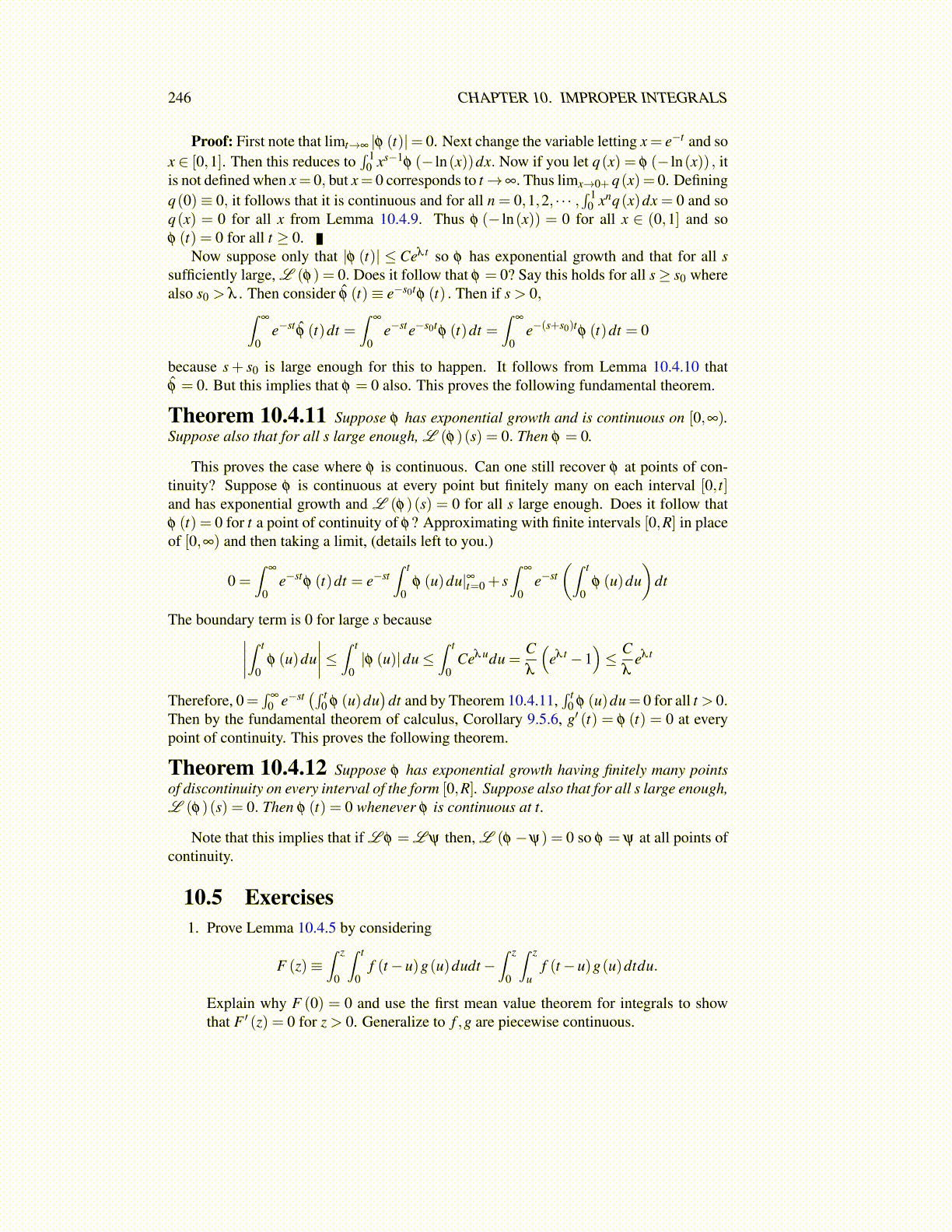
246 CHAPTER 10. IMPROPER INTEGRALS
8. Verify the following short table of Laplace transforms. Here F (s) is L f (s).
f (t) F (s) f (t) F (s) f (t) F (s)tneat n!
(s−a)n+1 tn,n ∈ N n!sn+1 eat sinbt b
(s−a)2+b2
eat cosbt s−a(s−a)2+b2 f ∗g(t) F (s)G(s)
9. Let r be a positive integer. Then if f (x) = 1Γ(r/2)2r/2 x(r/2)−1e−x/2, this function is
called a chi-squared density, denoted as X 2 (r). Show for each r,∫
∞
0 f (x)dx = 1.This particular function is the basis for a large part of mathematical statistics.
10. The Fresnel integrals are∫ x
0 sin(t2)
dt,∫ x
0 cos(t2)
dt for x > 0. This problem is onthe limit of these as x→ ∞. In an earlier problem this limit was shown to exist. Thislimit is probably most easily done in the context of contour integrals from complexanalysis. However, here is a real analysis way. Justify the following steps. Let
F (x)≡(∫ x
0 eit2dt)2
F ′ (x) = 2(∫ x
0eit2
dt)(
eix2)= 2x
(∫ 1
0eix2t2
dt)(
eix2)= 2x
(∫ 1
0eix2(t2+1)dt
)
F (x) = 2∫ x
0
∫ 1
0yeiy2(t2+1)dtdx =
∫ 1
0
∫ x
02yeiy2(t2+1)dxdt
=∫ 1
0
(−ieiy2(t2+1)
t2 +1|x0
)dt =
∫ 1
0
(i
1t2 +1
− ieix2(t2+1)
t2 +1
)dt
Let u = t2 + 1 so t =√
u−1 and du = 2√
u−1dt. Then in terms of u, the second
integral is i 12∫ 2
1eix2u
u(u−1)1/2 du. This converges to 0 as x→ ∞ by the Riemann Lebesgue
lemma and the observation that the improper integral∫ 2
11
u(u−1)1/2 du<∞. Therefore,
(limx→∞
∫ x
0eit2
dt)2
= iπ
4= i∫ 1
0
1t2 +1
dt
and so∫
∞
0 eit2dt =
∫∞
0 cos(t2)
dt + i∫
∞
0 sin(t2)
dt =√
22
√π
2 + i√
22
√π
2 or −√
22
√π
2 −i√
22
√π
2 .The first of the two alternatives will end up holding. You can see this from ob-serving that
∫∞
0 sin(t2)
dt > 0 from numerical experiments. Indeed,∫ 10
0 sin(t2)
dt =0.58367 and for t larger than 10, the contributions to the integral will be small be-cause of the rapid oscillation of the function between −1 and 1.
11. Let a = x0 < x1 < · · ·< xn = b and let yi ∈ [xi−1,xi]≡ Ii. If δ : R→ (0,∞) , then thecollection {(Ii,yi)} is called a “δ fine division” if for each i,
Ii ⊆ (yi−δ (yi) ,yi +δ (yi)) .
Show that for any such function δ , there exists a δ fine division. Hint: If not, thenthere would not be one for one of
[a, a+b
2
],[ a+b
2 ,b]. Use nested interval lemma to
get a contradiction.